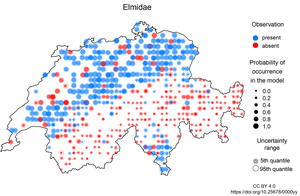Archive detail
Improved health check for running waters
December 2, 2019 |
If one turns a stone over in a river or stream, it swarms with tiny animals: caddisflies, water beetles, freshwater shrimp, and snails. The invertebrates living on the beds of water bodies that can be seen with the naked eye, called macroinvertebrates, are rather unimposing, but for science and the protection of surface waters they are of great importance. Several species in this group are very sensitive to changes in their environment, for example pollutants or construction along the shore or in the catchment area of the water body. On the other hand, some other species are tolerant to such influences. The diversity of the small animals therefore allows important conclusions concerning the water itself and the aquatic ecosystem as well. Sometimes they can even point to the causes of worsening ecological conditions.
Swiss-wide model-supported analysis of small invertebrates
For the first time, Eawag researchers Nele Schuwirth and Bogdan Caradima, together with colleagues in the Department of Systems Analysis, Integrated Assessment and Modelling, have carried out a combined analysis of cantonal and federal monitoring data on macroinvertebrates. For this study they used the database MIDAT of the “Schweizerisches Zentrum für die Kartografie der Fauna (SZKF)”. This database contains the macroinvertebrate data of the biodiversity monitoring BDM, the National Surface Water Quality Monitoring Programme NAWA and 14 cantonal monitoring programmes.
Because the programmes contain data on invertebrates identified at different taxonomic levels – family, genus, species - , the datasets first had to be harmonized. Then the researchers used statistical models to analyse the data and identify major direct and indirect influence factors for the occurrence of each taxonomic group. These included, among others, water temperature, use of insecticides in the catchment area, flow velocity, agricultural land use and forest cover along the river banks, urban area and livestock units in the catchment. Some of these influence factors, such as water temperature, are known to affect the organisms directly. Others serve as indicators for influence factors that cannot be measured directly. For example, the forestation of the riparian zone can lead to more leaf litter input, shading of the water body and reduced input of nutrients and pollutants from the catchment area.
Occurrence of the beetle family Elmidae in Switzerland in the biodiversity monitoring data and in the model. Large blue dots and small red dots indicate an agreement between observation and model.
From the results, the researchers have derived recommendations for the design of the monitoring programmes and surface water manageme
Identification of causes by determination of species
Investigations and evaluation of macroinvertebrates in Swiss running waters have been carried out according to the Swiss modular concept for stream assessment since 2010. It requires the recording of the organisms on the family level. The model analysis generally confirms the assessment method: families classified as sensitive respond more strongly in the model to anthropogenic stressors. At the same time, the study shows that a finer taxonomic resolution, namely the identification of species, would provide additional valuable information. This would allow a better identification of the specific causes that could influence water or water-body quality.
More data, increased validity
The greater the volume of data available for analysis, the higher the statistical power. For future analyses it is therefore essential that as many monitoring programs as possible submit their macroinvertebrate data as well as additional information like substrate data to the MIDAT database.
Unified monitoring concepts
Today, Cantons identify different groups of macroinvertebrates down to the species level. For a Swiss-wide evaluation, it would make sense to always identify the same groups in this detailed taxonomic resolution. A unified list of taxa for species identification would therefore be an advantage. The Eawag study can contribute to judging for which groups this would be especially valuable.
Extended monitoring design
To better disentangle major influence factors on freshwater communities, it is worthwhile to include additional locations to the monitoring programme. Locations with rare combinations of influence factors are especially valuable for the analysis, such as sites with low water temperature and impaired water quality.
Integral management of surface waters
Plants and animals living in surface water ecosystems are typically sensitive to multiple stressors, for example poor water quality, monotonous high flow velocity, and increased water temperatures. In considering measures to improve the ecological status of surface waters, a combination of measures should be recommended, as far as possible and necessary. For example a restoration combined with upgrading of water treatment plants and reduction of harmful agricultural inputs upstream.
Schuwirth and Caradima have published a more detailed summary of the results in today’s issue of the journal Aqua & Gas, in cooperation with the Federal Office for the Environment FOEN and the Atelier für Naturschutz und Umweltfragen AG UNA: “Analyse schweizweiter Makrozoobenthosdaten: Erkenntnisse über anthropogene Einflüsse und Monitoring Design”.
Original publication
Schuwirth et al., «Analyse schweizweiter Makrozoobenthosdaten: Erkenntnisse über anthropogene Einflüsse und Monitoring Designhttps://www.eawag.ch/typo3/#_msocom_1», Aqua & Gas, Nr. 12/2019
Funding
The studies were co-funded by the Federal Office for the Environment (FOEN) and the EU Horizon 2020-Programme (Projekt Aquacross, Grant agreement No. 642317).


